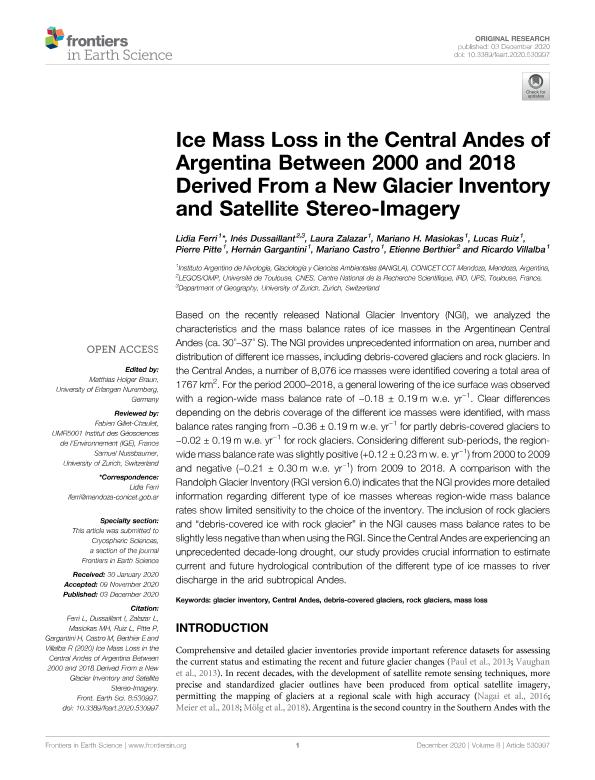Artículo
Ice Mass Loss in the Central Andes of Argentina Between 2000 and 2018 Derived From a New Glacier Inventory and Satellite Stereo-Imagery
Ferri Hidalgo, Lidia ; Dussaillant, Inés; Zalazar, Laura Viviana
; Dussaillant, Inés; Zalazar, Laura Viviana ; Masiokas, Mariano Hugo
; Masiokas, Mariano Hugo ; Ruiz, Lucas Ernesto
; Ruiz, Lucas Ernesto ; Pitte, Pedro Miguel
; Pitte, Pedro Miguel ; Gargantini, Hernan
; Gargantini, Hernan ; Castro, Mariano Agustin
; Castro, Mariano Agustin ; Berthier, Etienne; Villalba, Ricardo
; Berthier, Etienne; Villalba, Ricardo
 ; Dussaillant, Inés; Zalazar, Laura Viviana
; Dussaillant, Inés; Zalazar, Laura Viviana ; Masiokas, Mariano Hugo
; Masiokas, Mariano Hugo ; Ruiz, Lucas Ernesto
; Ruiz, Lucas Ernesto ; Pitte, Pedro Miguel
; Pitte, Pedro Miguel ; Gargantini, Hernan
; Gargantini, Hernan ; Castro, Mariano Agustin
; Castro, Mariano Agustin ; Berthier, Etienne; Villalba, Ricardo
; Berthier, Etienne; Villalba, Ricardo
Fecha de publicación:
12/2020
Editorial:
Frontiers Media S.A.
Revista:
Frontiers in Earth Science
ISSN:
2296-6463
Idioma:
Inglés
Tipo de recurso:
Artículo publicado
Clasificación temática:
Resumen
Based on the recently released National Glacier Inventory (NGI), we analyzed the characteristics and the mass balance rates of ice masses in the Argentinean Central Andes (ca. 30°–37° S). The NGI provides unprecedented information on area, number and distribution of different ice masses, including debris-covered glaciers and rock glaciers. In the Central Andes, a number of 8,076 ice masses were identified covering a total area of 1767 km2. For the period 2000–2018, a general lowering of the ice surface was observed with a region-wide mass balance rate of −0.18 ± 0.19 m w.e. yr−1. Clear differences depending on the debris coverage of the different ice masses were identified, with mass balance rates ranging from −0.36 ± 0.19 m w.e. yr−1 for partly debris-covered glaciers to −0.02 ± 0.19 m w.e. yr−1 for rock glaciers. Considering different sub-periods, the region-wide mass balance rate was slightly positive (+0.12 ± 0.23 m w. e. yr−1) from 2000 to 2009 and negative (−0.21 ± 0.30 m w.e. yr−1) from 2009 to 2018. A comparison with the Randolph Glacier Inventory (RGI version 6.0) indicates that the NGI provides more detailed information regarding different type of ice masses whereas region-wide mass balance rates show limited sensitivity to the choice of the inventory. The inclusion of rock glaciers and “debris-covered ice with rock glacier” in the NGI causes mass balance rates to be slightly less negative than when using the RGI. Since the Central Andes are experiencing an unprecedented decade-long drought, our study provides crucial information to estimate current and future hydrological contribution of the different type of ice masses to river discharge in the arid subtropical Andes.
Archivos asociados
Licencia
Identificadores
Colecciones
Articulos(IANIGLA)
Articulos de INST. ARG. DE NIVOLOGIA, GLACIOLOGIA Y CS. AMBIENT
Articulos de INST. ARG. DE NIVOLOGIA, GLACIOLOGIA Y CS. AMBIENT
Citación
Ferri Hidalgo, Lidia; Dussaillant, Inés; Zalazar, Laura Viviana; Masiokas, Mariano Hugo; Ruiz, Lucas Ernesto; et al.; Ice Mass Loss in the Central Andes of Argentina Between 2000 and 2018 Derived From a New Glacier Inventory and Satellite Stereo-Imagery; Frontiers Media S.A.; Frontiers in Earth Science; 8; 12-2020; 1-16
Compartir
Altmétricas



